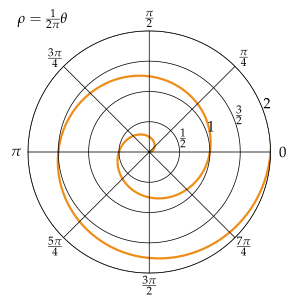Archimedean spiral

The Archimedean spiral (also known as the arithmetic spiral) is a spiral named after the 3rd-century BC Greek mathematician Archimedes. It is the locus of points corresponding to the locations over time of a point moving away from a fixed point with a constant speed along a line that rotates with constant angular velocity. Equivalently, in polar coordinates (r, θ) it can be described by the equation
with real numbers a and b. Changing the parameter a turns the spiral, while b controls the distance between successive turnings.
From the above equation, it can thus be stated: the position of particle from the point of start is proportional to the angle as time elapses.
Archimedes described such a spiral in his book On Spirals.
Derivation of general equation of spiral
Template:See also A physical approach is used below to understand the notion of Archimedean spirals. Suppose a point object moves in the cartesian system with a constant velocity directed parallel to the x-axis, with respect to the x-y plane. Let at time , the object was at an arbitary point . If the x-y plane rotates with a constant angular velocity about the Z-axis, then the velocity of the point with respect to Z-axis may be written as:

Here is the modulus of the position vector of the particle at any time , is the velocity component along x-axis and is the component along y-axis. The figure shown alongside explains it.
The above equations can be integrated by applying integration by parts, leading to the following parametric equations:
Squaring the two equations and then adding (and some small alterations) results in the cartesian equation
(using the fact that and )
or
Its polar form,
Characteristics
The Archimedean spiral has the property that any ray from the origin intersects successive turnings of the spiral in points with a constant separation distance (equal to 2πb if θ is measured in radians), hence the name "arithmetic spiral". In contrast to this, in a logarithmic spiral these distances, as well as the distances of the intersection points measured from the origin, form a geometric progression.

The Archimedean spiral has two arms, one for θ > 0 and one for θ < 0. The two arms are smoothly connected at the origin. Only one arm is shown on the accompanying graph. Taking the mirror image of this arm across the y-axis will yield the other arm.
For large θ a point moves with well-approximated uniform acceleration along the Archimedean spiral while the spiral corresponds to the locations over time of a point moving away from a fixed point with a constant speed along a line which rotates with constant angular velocity[1] (see contribution from Mikhail Gaichenkov).

General Archimedean spiral
Sometimes the term Archimedean spiral is used for the more general group of spirals
The normal Archimedean spiral occurs when c = 1. Other spirals falling into this group include the hyperbolic spiral (c = −1), Fermat's spiral (c = 2), and the lituus (c = −2). Virtually all static spirals appearing in nature are logarithmic spirals, not Archimedean ones. Many dynamic spirals (such as the Parker spiral of the solar wind, or the pattern made by a Catherine's wheel) are Archimedean.
Applications
One method of squaring the circle, due to Archimedes, makes use of an Archimedean spiral. Archimedes also showed how the spiral can be used to trisect an angle. Both approaches relax the traditional limitations on the use of straightedge and compass in ancient Greek geometric proofs.[2]

The Archimedean spiral has a variety of real-world applications. Scroll compressors, made from two interleaved involutes of a circle of the same size that almost resemble Archimedean spirals, are used for compressing gases.[3] The coils of watch balance springs and the grooves of very early gramophone records form Archimedean spirals, making the grooves evenly spaced (although variable track spacing was later introduced to maximize the amount of music that could be cut onto a record).[4] Asking for a patient to draw an Archimedean spiral is a way of quantifying human tremor; this information helps in diagnosing neurological diseases. Archimedean spirals are also used in digital light processing (DLP) projection systems to minimize the "rainbow effect", making it look as if multiple colors are displayed at the same time, when in reality red, green, and blue are being cycled extremely quickly.[5] Additionally, Archimedean spirals are used in food microbiology to quantify bacterial concentration through a spiral platter.[6] They are also used to model the pattern that occurs in a roll of paper or tape of constant thickness wrapped around a cylinder.[7][8]
Code for producing an Archimedean spiral
The following R code produces the first graph above.
a <- 1.5
b <- -2.4
t <- seq(0,5*pi, length.out=500)
x <- (a + b*t) * cos(t)
y <- (a + b*t) * sin(t)
plot(x,y, type="l", col=2, lwd=3)
abline(h=0, v=0, col="grey")
See also
- Archimedes' screw
- Euler spiral
- Fermat's spiral
- Golden Spiral of Fibonacci
- Hyperbolic spiral
- List of spirals
- Logarithmic spiral
- Spiral of Theodorus
- Triple spiral symbol
References
External links
- Jonathan Matt making the Archimedean spiral interesting - Video : The surprising beauty of Mathematics - TedX Talks, Green Farms
- Template:MathWorld
- Template:PlanetMath
- Page with Java application to interactively explore the Archimedean spiral and its related curves
- Online exploration using JSXGraph (JavaScript)
- Archimedean spiral at "mathcurve"
- ↑ Template:Cite OEIS
- ↑ Template:Cite book
- ↑ Template:Cite web
- ↑ Template:Cite web. See the passage on Variable Groove.
- ↑ Template:Citation
- ↑ Template:Cite journal
- ↑ Template:Cite web
- ↑ Template:Cite book






















